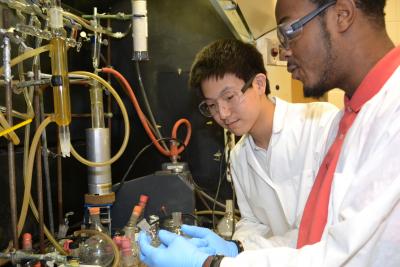Summer Chemistry Mentoring Program Wraps Up Fourth Year
Fri, 08/24/2012 - 03:12pm | By: Tara Burcham

The department of Chemistry and Biochemistry at The University of Southern Mississippi has just wrapped up the fourth successful year of project SEED, a high school mentoring program.
Dr. Douglas Masterson, SEED coordinator, explains that the program involves a partnership between Southern Miss and the American Chemical Society (ACS) with support from the Office of the Provost and the College of Science and Technology Dean's office.
SEED is open to qualified students entering their junior or senior year in high school. “Project SEED provides an opportunity for high school students interested in chemistry to conduct cutting edge research in an apprenticeship-like manner” said Masterson.
SEED offers students a hands-on way to discover possible career paths. “Working with ACS, we are able to reach students at an important time in their lives,” said Masterson. “These are scientifically talented students choosing their future career. The SEED experience hopefully influences them to choose a career in science.”
Su-Hwan “Paul” Lee, a student at Oak Grove High School participated along with Caleb Faulker from Hattiesburg High School.
According to Lee, his work this summer included “electrochemical experiments of ferricyanide and two types of ion-selective electrodes: Copper Ion Selective electrode and a pH glassy electrode.”
Lee's mentor, Associate Professor, Dr. Wujian Miao, explains Lee was using these elements to fabricate a copper selective electrode and to use it to monitor trace amounts of copper ions in water samples.
Lee said he decided to apply for the SEED program because he really liked chemistry. However, he found his work this summer at Southern Miss went far beyond his high school experiences. “What I found most interesting was that the chemistry in high school and what I am doing right now are really different,” he said.
Faulkner said he was excited about the SEED program because he “loves science.” “I plan on being a doctor and my family and I all thought it was a good opportunity for me.”
Masterson served as Faulkner's faculty mentor. Faulkner also worked with Masterson's doctoral student, Souvik Banerjee.
Masterson notes that the SEED program allows high school students to learn complex scientific concepts. Faulkner agreed saying, “it sounds so complicated at first, but when you begin to work with it, it's not that hard. I've been working with proline this summer and it's pretty cool.”
But SEED prepares students for more than just scientific study. Lee learned how college works. “In addition to science and chemistry, I have learned a lot about the admission process and scholarships at university.”
Lee says the SEED program allowed him to solidify his choice of a major in college, “I will definitely choose biochemistry as a major or minor in college. The most important thing I wanted to learn in this program was how to work with others cooperatively and what to do with something I haven't learned before.”
SEED students work 40 hours per week for eight weeks as real-world paid collaborators in a professor's laboratory. The program allows continuing high school students who complete their first summer to return for a second summer of research with an additional paid award.
The ACS designed Project SEED for ambitious, motivated, and hard-working students with an academic record of success in high school science courses. Teacher recommendations were also included in the project criteria.
Lee says he hoped to get a number of things out of his SEED experience. “Prepare for college, and learn more about science, and spend a summer doing something special. I have done many volunteer works before, but this was my first job to get paid.”
Faulkner says the SEED program “heavily” influenced his selection of a future career.
“I thought I was going to be a typical pre-med, biology major student but doing Project SEED has made me think twice about that.” Faulkner's project work is currently under review for publication in The Journal of Organic Chemistry. “How many high school students can say they have co-authored a scientific paper?” asked Masterson.
Masterson notes the SEED program teaches more than science. “Having students on a university campus teaches them about the next step in their lives,” he said. “They might be less intimidated their first few days on campus thanks to project SEED.”
Faulkner sums up the benefits of project SEED, “This is something that they just can't show you in high school. This is definitely preparing me more for college and I'm definitely learning more about science.”
Masterson said he hopes Project SEED will help get more students in to chemistry while increasing enrollment at Southern Miss. “This is certainly a good recruiting tool for the University and the College of Science and Technology. Getting students involved in on-campus activities provides the students with a sense of what Southern Miss can offer beyond the classroom.” he said.
For more information about the Southern Miss SEED program, contact Masterson at 601.266.4714.

